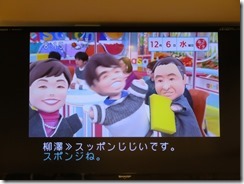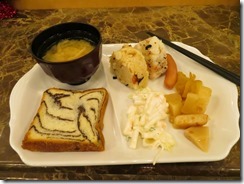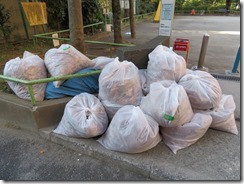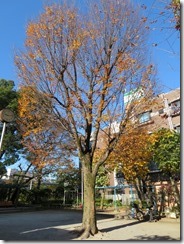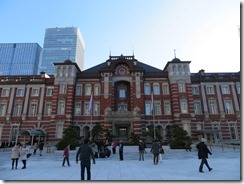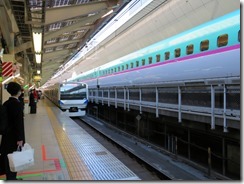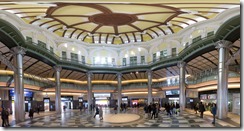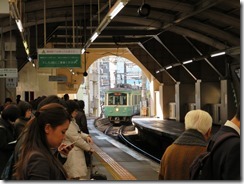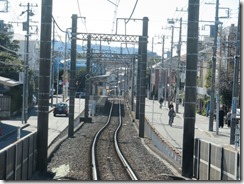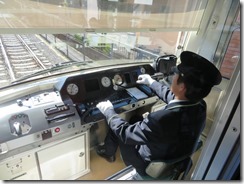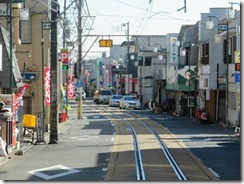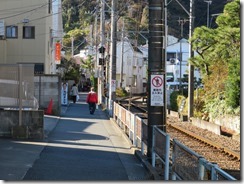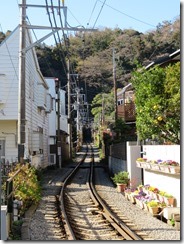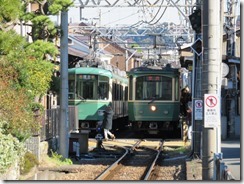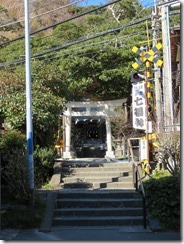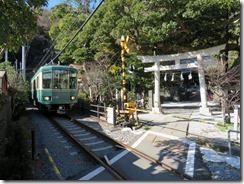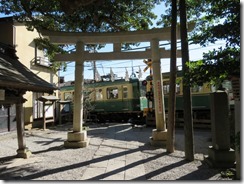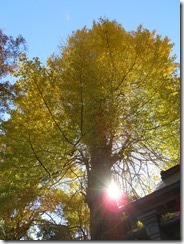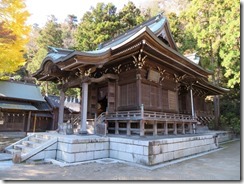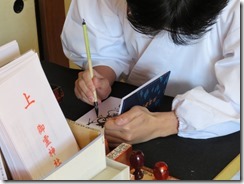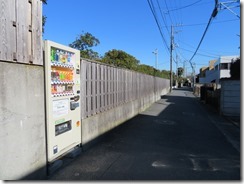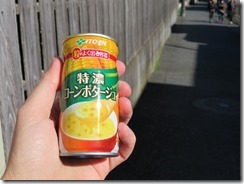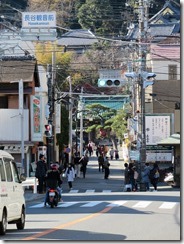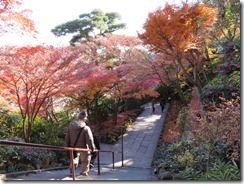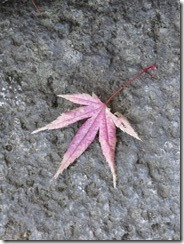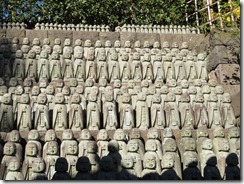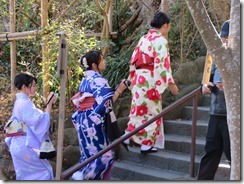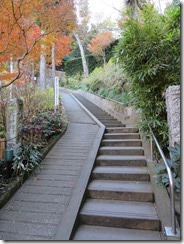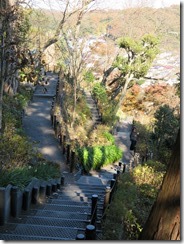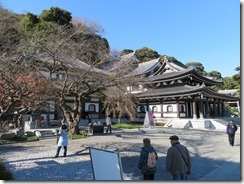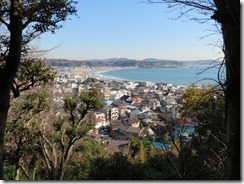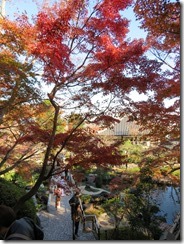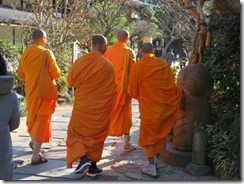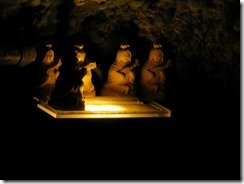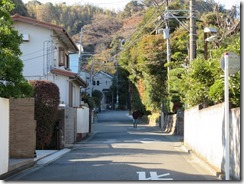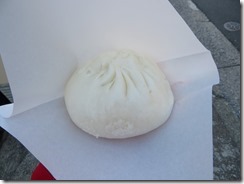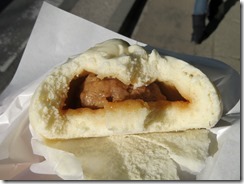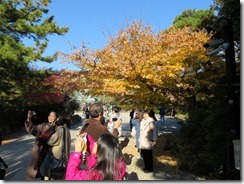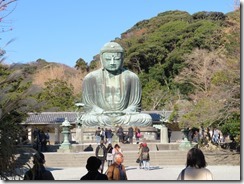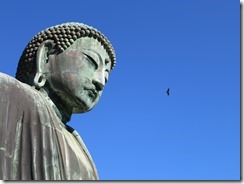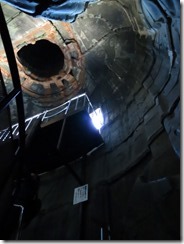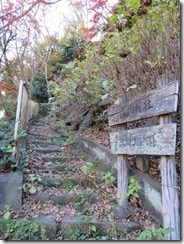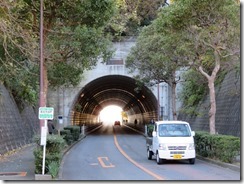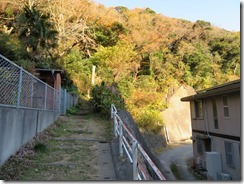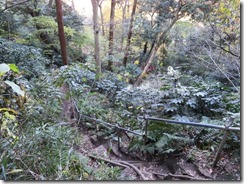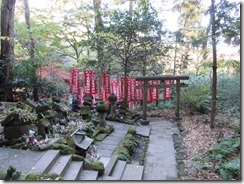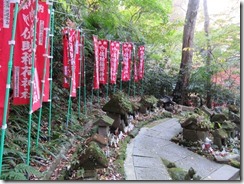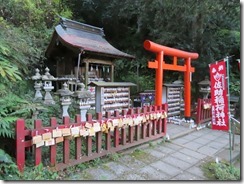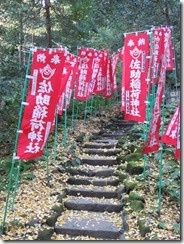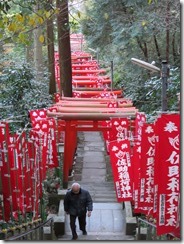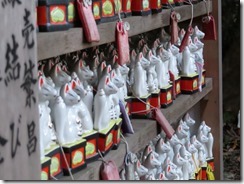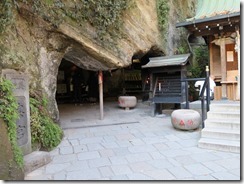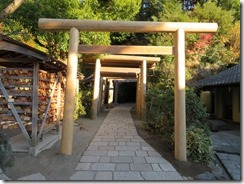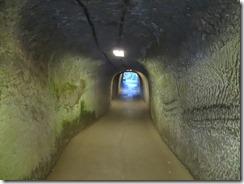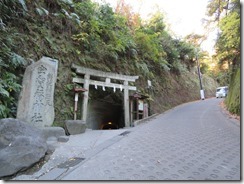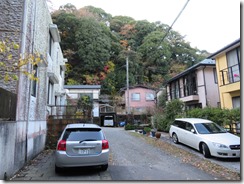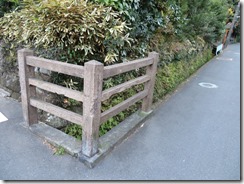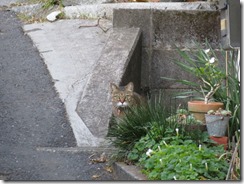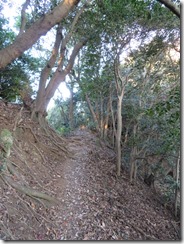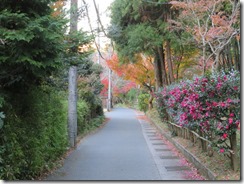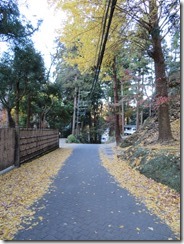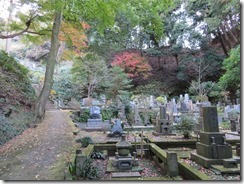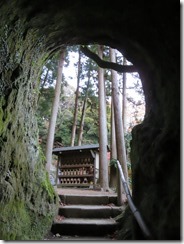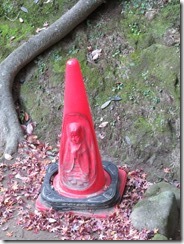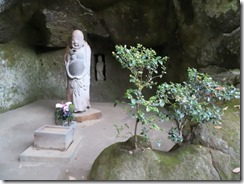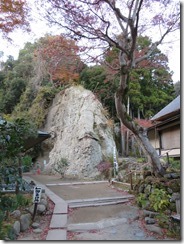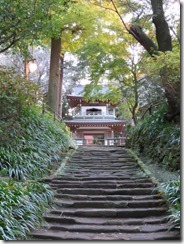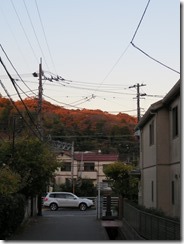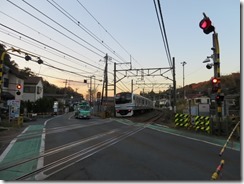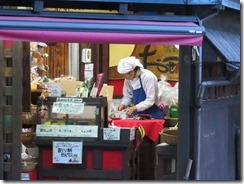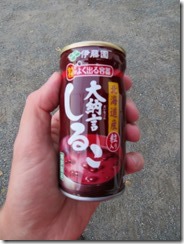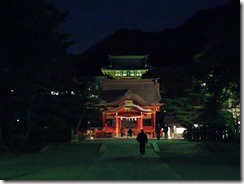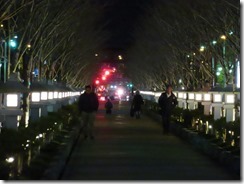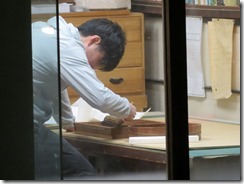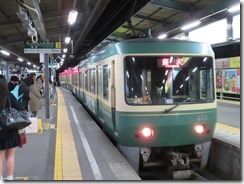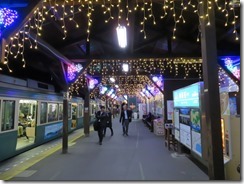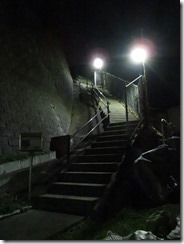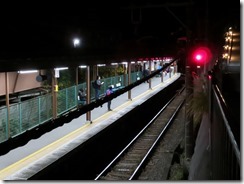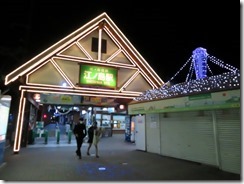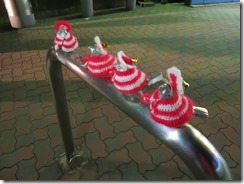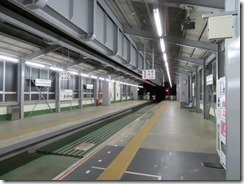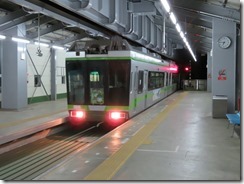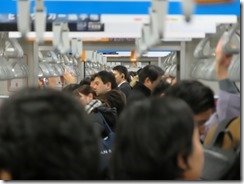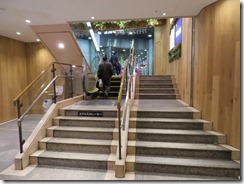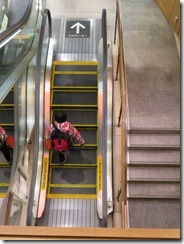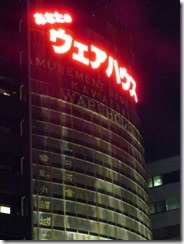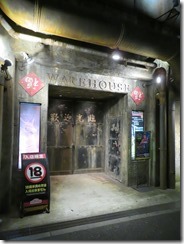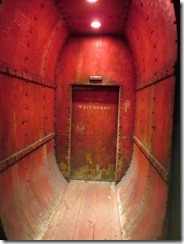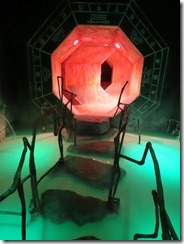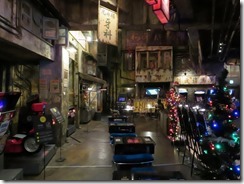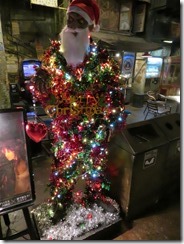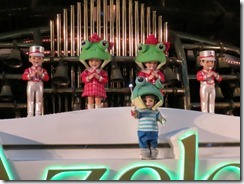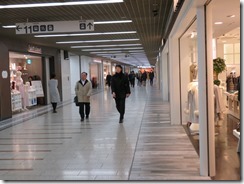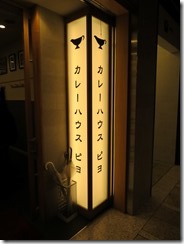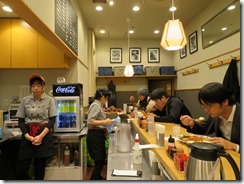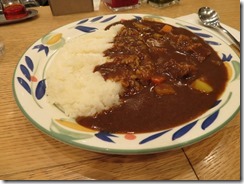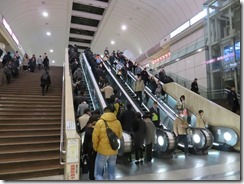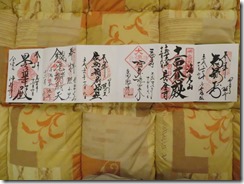Continuing my trend of alternating late nights with less-late nights, it was 10pm before I even arrived back at the hotel…
Pokémon Go is still reasonably popular over here. At least in the city, if I go to a raid, I can usually find others fighting it, and today I found a Pokémon Go walking map published by an official city tourism department, complete with Pokestops and gyms marked.
So, today dawned absolutely bright and sunny, so after breakfast, I hastily enacted my “absolutely bright and sunny” contingency plans… no wait, no I didn’t. I continued with the plans that had been displaced from yesterday: Visiting Kamakura. I dropped by the park near the hotel again on the way to the station, and was amused to discover even fewer leaves on the tree, and more collected in bags on the ground.
My first trip outside of Tokyo Prefecture since I arrived (though still within the Greater Tokyo Area), Kamakura is a part of the neighbouring Kanagawa Prefecture. Kamakura became the de facto capital of Japan for about a hundred and fifty years (from 1185 until the Kenmu Restoration in 1333, when the Emperor took back control of the country) when the very first Shogun, Minamoto no Yorimoto, chose the city as his base of operations – partly because his ancestral land was here, and partly because it’s surrounded on three sides by mountains (and the sea on the fourth) and therefore effectively impregnable. (Fun fact, though the government run by the Shogun is called “shogunate” in English, the word in Japanese is “bakufu” meaning “tent government”, both because the tent is the symbol of a military commander, and because it was intended to be temporary.)
Headed there via Tokyo Station – my first visit to the station since my arrival in Japan. I thought I’d just pop outside the gates and grab the station stamp, but I wound up checking literally every single one of the stations six main gates before I found the one that had the stamp. Fun stuff. (Incidentally, it’s possible that the Metro stations I visited the other day all had stamps as well, though looking for them would have probably taken me all day, considering how spread out some of those stations are.) I did get a look at the historic Marunouchi entrances, though – last time we were here, they were in the middle of being refurbished, and covered in scaffolding.
Hopped onto the Tokaido Main Line train to Fujisawa. There, I transferred to the Enoshima Dentetsu line, or Enoden for short. A lovely little train line that runs from Fujisawa to Kamakura, it’s officially designated a tramline, as the part of the line from Enoshima Station to Koshigoe Station runs down the middle of a road (making the whole line, legally speaking, one of the three tramlines remaining in Greater Tokyo). I bought me a day pass for the line, as I intended to visit a whole bunch of different stations. There’s a whole lot of very nice stations on this line, including Kamakura Koko-Mae Station, which is almost right on the seashore, and Gokurakuji Station, a little station in the hills.
I also found a special stamp inside the station intended to advertise a new movie coming out soon called “Destiny” – it looks like it’s got a whole bunch of different stamps of different colours, which together combine to make a pretty coloured image. Trouble is, that was the only stamp I saw all day, so I’ve no idea what it’s supposed to look like…
But anyway, after riding most of the way along the line, I hopped off at Hase Station to start my first main activity for the day: the Kamakura Shichifukujin Meguri. Mostly I decided on doing this (despite my aborted attempt in Yanaka the other day) because most of the temples on the pilgrimage were on my list of temples I’d like to see anyway, and/or they were on the way.
First stop, backtrack up the tracks a little bit to Goryo Jinja, a lovely little shrine in the trees… with the Enoden running literally across its doorstep. As in, right outside the tori gate marking the entrance, there’s a level crossing. Anyway, the shrine enshrines Fukurokuju, the god of wealth, happiness and longevity (which is actually his name, too – fuku=wealth, roku=happiness, ju=longevity).
Left the shrine via the back stairs, and walked through the quiet little streets to the next temple, on the way buying a nice hot can of corn potage from a handy vending machine – with actual corn. Very nice to hold.
In any case, the next temple was Hase-dera, which enshrines Daikokuten, the god of agriculture, farming, wealth, and commerce. Or supposedly so, anyway – I never saw his statue, but maybe I was looking in the wrong place. I did certainly notice a cave devoted to Benzaiten, goddess of beauty and music (and the only female member of the Seven Lucky Gods).
In contrast to Goryo Jinja, Hase-dera is a huge place, with buildings everywhere, built up the side of a mountain which gave it a spectacular view over Kamakura. Also a restaurant. And wi-fi. And it cost money to enter – and they had Suica-enabled ticket machines. And also a rinzo, a huge rotating pillar thing full of written Buddhist sutras – according to a sign, turning the rinzo is supposed to give you the same spiritual benefit as actually reading all the sutras, which seems heaps convenient, but you can only turn it on the eighteenth of the month. Anyway, I bought some dango (sweet rice dumplings) as a snack – most tasty.
Headed off to my next temple, buying a huge nikuman (Chinese meat bun) as a further snack-slash-lunch. While the next temple, Kotoku-in, is not part of the Shichifukushin Meguri, you may have heard of it for a different reason: it’s the location of the Great Buddha of Kamakura, one of the most famous icons of Japan. It was built in maybe 1252, which for someone who lives in a country where the oldest building is no more than 200 years old, is unimaginably old. It used to be housed in a building, but the most recent one washed away in a tsunami in 1498, so it’s now exposed to the air. Also, it’s hollow, and you can go inside.
Once done there, I headed back on the road. It was quite a nice little back street, but at one point it crossed a major road, which disappeared into tunnels after about a hundred metres in either direction, which I found interesting – just goes to show how mountainous Kamakura is. Kept following my little street until it turned into a hiking path, which climbed up the side of another mountain and went right over the top, descending down into a little hidden valley on the other side, which contained my next destination: Sasuke Inari Shrine.
Again, this one’s not on the Shichifukujin Meguri, but I’m sure I’ve mentioned in the past how much I luuuurve Inari shrines. This one was particularly nice. Considering the path I walked in on, I completely felt I’d discovered a completely hidden shrine – that feeling was dissipated a little when I discovered it’s accessible by a paved path on the other side, but it was still a very nice little place. When I went to get a goshuin, though, the priest literally just took a pre-written one and glued it into my book.
Headed out of there by the road, and walked towards my next stop, Zeniarai Benzaiten Shrine. Despite enshrining Benzaiten, this one’s also not on the Shichifukujin Meguri (Benzaiten’s temple comes later). Walking the back streets as is my wont, I managed to reach this one by the back entrance as well – the shrine is completely surrounded by high rock walls, making it invisible from the outside, and while the back entrance is a flight of stairs up and over (meaning for the second time I wound up clambering up and over a mountain… ish), the main entrance is a tunnel straight through (though historically, the stairs were the main entrance).
Zeniarai Benzaiten is unusual in that it contains features of both Buddhist temples (the incense, for example) and Shinto shrines (the tori gates) – one of the few survivors of the forced separation of Buddhism and Shinto during the Meiji restoration. The shrine’s main tradition is washing money (that is, in fact, what “zeniarai” means) – supposedly, any coins washed in the shrine’s stream will double. I bought a money basket and washed my own coins – I’m gonna need more hundred-yen coins when it comes time to start paying for coin laundries or coin lockers – before heading out, by the tunnel this time.
Hiked up the steeply sloped street, and found myself clambering up and over another mountain. Crossed the valley on the other side – this one full of houses. So absolutely serene and remote, yet still pretty close to a main JR railway line. Coming to the next mountain, Google maps was telling me there was no path over the top so I’d have to go around, but Pokémon Go was showing me a continuous route. Didn’t want to have to backtrack, so I went with the latter. Turns out that PoGo is correct, but only in the sense that part of the route was literally someone’s private side path. Whoops. Didn’t realise I’d entered private property until I was leaving it.
Anyway, after clambering over my… fourth mountain (?) for the day, I finally reached my next stop on the Shichifukujin Meguri. Stop number three, in fact, once again approaching from behind. Jochi-ji enshrines Hotei, the god of “contentment, happiness, bartenders, and all classes of people” (is how it’s phrased on the website I’ve been using for reference, which is an interesting combination), and is also the fourth-ranked of Kamakura’s Five Great Zen Temples. It was built in this absolutely spectacular cedar forest. Very lovely.
Aaaand… that’s all I had time for. By this point, it was 4:30, and all the temples were closing for their evening prayers. Also, it was time for the monthly SpockSoc book club meeting, which I’d be taking part in via FaceTime. I bought a can of hot red bean soup (very warm, but quite curious flavour) to warm up again, then popped into a temple car park so I could hear people talk without traffic noises. Quite by pure coincidence, it happened to be the car park of Kencho-ji, the number one temple of Kamakura’s Five Great Zen Temples. I could probably have snuck into the evening service – the attendant was still there letting people in – but I’m not sure they’d have appreciated me chattering on FaceTime up the back.
Once traffic died down a bit, I headed on down the road, still chattering with SpockSoc. Walked through what appeared to be a tunnel, but which was open at the top – very curious – and eventually reached the next stop on the Shichifukujin Meguri, Tsurugaoka Hachiman-gu.
Enshrining Benzaiten, this is like the major shrine in Kamakura. Like, town’s main road points at it in the same way the Champs-Élysées points at the Arc de Triomphe. And I once again came in through the back door. I elected to do this pilgrimage in clockwise geographic order so that I’d finish at Kamakura Station (there’s a numerical order, but it’s not very ordered geographically), but it kinda seems like the temples are oriented to be approached from the other direction. That said, I managed to get all the best temples before running out of light, so I guess clockwise works – near as I can tell, most of the ones remaining were smaller and less spectacular.
In any case, Tsurugaoka Hachiman-gu was well and truly shut up for the night, though I could at least wander the grounds. I could see people moving around behind the windows, but they were probably counting takings, or something – I’m sure if I’d knocked and asked, they would have done a goshuin for me in the name of service, but they wouldn’t have been happy about it. Took a few photos, then headed back to Kamakura Station down the aforementioned main road, Wakamiya Oji, which a raised approach road lined with stone lanterns running right down the median strip.
Back at the station, still chattering with SpockSoc, I hopped back onto the Enoden. I was intending to head all the way to Enoshima, but instead I got off at Hase again, partly so that I could take part in the next phase of the book club meeting (can’t speak on the train, it’s bad manners), and partly to take photos of the Christmas lights I’d noticed earlier and which were now lit up. With Enoden trains running every twelve minutes, randomly disembarking is not a huge issue, and, in fact, had originally been my plan had I not ran out of time.
I also got off at the next station, Gokurakuji, and took some more photos, but it was just too dark to do anything much. So yeah. I think if I wanted to get everything done that I’d planned, I either needed less sleep (i.e. start earlier), less travel time (i.e. start closer), more daylight (i.e. finish later), or more focus on what I was doing (i.e. stop getting distracted by stuff). Or some combination of all four. Or fewer plans (i.e. don’t bite off more than I can chew). As it were, I only managed three of the seven, though if I can count Zeniarai Benzaiten as Benzaiten, I guess I did four. Didn’t manage anything related to Ebisu, Bishamonten or Jurojin.
Finally, headed back to Enoshima Station to continue my original plan: ride the Shonan Monorail back to Ofuna, where I could catch the Tokaido Line, though I did rather want to do that in daylight. See, the Shonan Monorail is a suspended monorail, with the cars riding under the track. I’d never done that before, and it looks quite impressive, with nothing between you and the cars on the road below except for the floor of the carriage. The monorail even runs through tunnels. Spent the whole trip with my face pressed to the front window, but it was just too reflective to take photos.
In Ofuna, I tried to find the station stamp, which turned out to be a bit of an adventure. Usually they’re set up by one of the ticket gates, basically just sitting there all the time, but sometimes the worker at the manned gate has it behind his desk. In Ofuna, it’s kept in the station’s lost-and-found office, this tiny room hidden under the stairs right down the far end of platform six. As in, it’s actually on the platform. Probably a nice view during the day, I’d imagine.
Once again, same as the other day, even thought it was already getting late, I went to see a couple more sights, both adjacent to Kanazawa Station. First: the world’s shortest escalator. As in, it’s officially recognised by the Guinness Book of Records. It’s about five steps high, but you need to walk up another five steps just to get to it, which is a bit weird. Internet research indicates that more fuss used to be made about it there, with posters and whatnot, but currently it’s basically just sitting there unremarked. Maybe it was getting too much attention. Also, it used to run down instead of up.
Anyway, next activity was Anata no Warehouse. It’s a five-storey arcade building, but it’s done up to look like a dilapidated, cyberpunk version of a Kowloon walled city. Very ratty-looking, very nice. The entrance from the car park involves walking on stepping stones over “toxic waste”, so I’m not sure I’d want to do that while drunk. I took a bunch of photos before noticing the sign saying “no photos”, so I quietly snuck out before anyone noticed me.
I had dinner at the shopping arcade attached to Kawasaki Station – Japanese-style curry – before heading back to my hotel. Finally managed to confirm something that I’ve vaguely been suspecting for a while: the trains have heated seats. Quite nice.
But yes. Getting pretty late now, so it’s time for bed. Tomorrow I’m checking out of my hotel in Tokyo and heading to my next destination. It’s only a three hour trip, so I shouldn’t need to be up too late. Touch wood.
Today’s photo count: One thousand and forty-three. Cracked the three-digit mark for what I’m pretty sure is the first time ever. Don’t ask me how that happened.
Today’s pedometer count: 26,592 steps, or 19.4km. Whew, we have a new record here as well.
Today’s goshiun count: Six, a pretty impressive haul. From right to left as usual, Goryo Jinja, Hase-dera, Kotoku-ji, Sasuke Inari Shrine, Zeniarai Benzaiten Shrine, Jochi-ji
Today’s stamp count: Lucky thirteen, another big take. Tokyo Station, Fujisawa Tourism Information Centre (cause I found it while looking for the Fujisawa Station stamp), Fujisawa Station, Kamakura JR Station, Kamakura Enoden Station, Hase Station, Gokurakuji Station, Enoshima Station, Shonan-Enoshima Station, Ofuna Monorail Station (two different ones, for some reason), Ofuna JR Station, Kawasaki Station. Also, one part of a multi-colour Destiny stamped image, so I guess that counts as fourteen? =)

